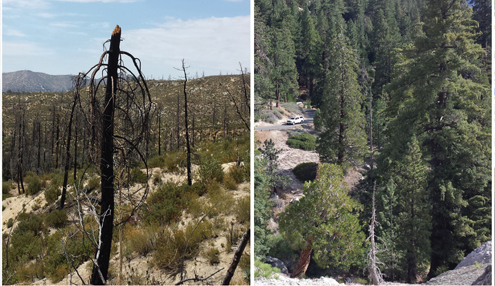
A burnt shell of a tree (left) remains five years after the Station Fire swept through the Angeles National Forest. When compared to acres of nearby land untouched by the blaze, the long lasting effects of the state’s largest wildfire are obvious.
By Mary O’KEEFE
It has been five years since the hills above Tujunga, far north Glendale, La Crescenta and La Cañada Flintridge were ablaze. The fire that started as a small brush fire on Aug. 26, 2009 grew into the largest wildfire in California history. At containment on Oct. 16, 2009, the fire had burned 161,189 acres of the Angeles National Forest and had cost the lives of two L.A. County firefighters.
“The heat, humidity and fuel temperatures were at the highest extreme. The position of the fire in the forest was in the most ridged terrain,” said Deputy Chief John Tripp of the Los Angeles County Fire Dept.
On Aug. 26, the fire had been fought by Los Angeles County Fire and was under control with no immediate danger to structures. Firefighters stayed in the area to watch for flare-ups. At that point it had covered 20 acres; embers would fly and catch the dry vegetation on fire occasionally.
“We went down [the hillside] five times [that night],” Tripp said.
The first night the fire, which was under the jurisdiction of the U.S. Forest Service, seemed to be contained or at the very least controlled. The fire burned the second day and into the night, but this time in very steep terrain. Water dropping air ships were available via L.A. City and L.A. County fire departments. The forest service policy at that time required that agencies bring in aircraft only if there was a threat to structures. Without that threat, as one firefighter put it, “We would need an invitation. We didn’t get invited.”
It was later learned that an airship had been requested and was responding until the crew received a medical emergency call, which took priority.
Soon there were mandatory evacuations along the foothills as flames raced down the hillsides.
The area was ready to burn. The chaparral was extremely dry and in some areas the vegetation had not burned in 45 to 90 years, and the terrain was steep and rugged.
On Aug. 29, the fire made national forest history by covering 30,000 acres in one run.
“Only to be eclipsed the next day in a 50,000 acre run,” Tripp said.
“The trees created those intense temperatures. [The fire] created its own weather.”
He added at one point in an area called Mill Creek the fire created winds of 47 mph.
On Aug. 31, the fire took the lives of L.A. Fire Capt. Tedmund “Ted” Hall, 47, and Specialist Arnaldo Quinones, 34. The two drove off the side of a mountainous road near inmate Camp 16 near Mt. Gleason. Correction workers, fire personnel and inmates were trapped by the fire. The two firefighters were attempting to find safe passage out.
The fire had been determined to be human caused and with the deaths of the two firefighters L.A. County Sheriff’s homicide bureau took over the arson investigation.
“The investigation is still active,” said Lt. Mike Rosson this week. “We do not currently have a person of interest. As of last week we were following up on leads.”
Although there are stories shared on social media that everyone from transients to marijuana growers were seen in the area, homicide detectives do not have any valid person or persons of interest.
The aftermath of the fire left not only a barren forest with wildlife scrambling to find shelter and food, but also questions of how in the future wildfires in a national forest should be fought.
From the beginning of the Station Fire, L.A. County Supervisor Michael Antonovich questioned the U.S. Forest Service policy and procedure of fighting the fire.
“In the early hours of the fire, our office received reports from the Los Angeles County Fire Dept. indicating that they were waiting to be called in by the U.S. Forest Service to provide aerial and ground support,” Antonovich said. “Since the second day of the fire, questions arose from the community and our own county fire department as to whether the response and firefighting effort was the most aggressive and timely possible. Forest Service policies delayed the use of adequate air support, the installation of necessary fire breaks and the use of mechanized heavy equipment.”
Congressman Adam Schiff added his voice to the questions of policy. A congressional panel was convened to discuss the timeline of the fire and the equipment requested by the U.S. Forest Service from their mutual aid agreements with L.A. County and L.A. City fire.
“U.S. Forest policy did not allow night flying at the time. Also, the fire was relatively small the first night and didn’t really become aggressive until the next morning,” Antonovich said. “The second night of the fire television news reports captured the aircrafts leaving the Station Fire and being redeployed to a fire in Rancho Palos Verdes.”
Officials continued to push the U.S. Forest Service for answers. Congressman Schiff repeatedly sent letters requesting change … which did come. The U.S. Forest Service has changed policy and it has been proven to work in recent fires like the Colby fire.
Next week, the CVW will cover those changes and look at how the U.S. Forest Service and the community has helped the ANF recover from its most devastating wildfire.
